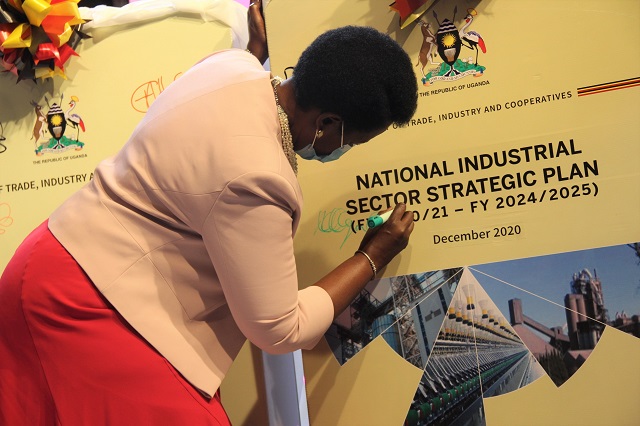
Kampala, Uganda | THE INDEPENDENT | The government has drawn a plan that it hopes will increase the level of industrialization to 31.7% of the value of the Ugandan economy (GDP) in the next 10 years up from the current 27% recorded in 2018/2019. The new National Industrial Plan, it is hoped will be supported by the implementation of the African Continental Free Trade Area, which among others is expected to increase market opportunities for industrial products by opening up borders.
Uganda’s industrial sector comprises manufacturing, construction, mining and utilities (like electricity, water and roads). Manufacturing is currently the largest component of the industrial sector, contributing 57.2% of the output. While the number of manufacturing enterprises stood at 5200 as of June 2020. By 2029/2030, the share of manufactured exports is expected to have grown from 22.5% in 2018/19 to 46.8%, according to the policy.
The manufacturing sector should also account for 15% of the job opportunities in the economy by then, up from the current 9.8%. “The policy focuses on addressing the gaps identified in the National Industrial Policy of 2008 and puts in place strategic measures to optimally benefit from the emerging opportunities, e.g. the AfCFTA,” says the Ministry of Trade, Industry and Cooperatives.
This new National Industrial Policy seeks to address the challenges that the government has identified by lowering the cost of manufacturing especially with regard to energy and transport. Through the policy, the government also hopes to increase the range of value-added competitive products to create more employment and improve Uganda’s trade balance through enhancing import substitution.
One other challenge that has repeatedly been cited by investors and prospective investors is the high cost of finance, with the most accessible source being commercial banks. Uganda has some of the highest interest rates in the region at an average of 18% per annum.
The Minister of Trade, Cooperatives and Industry, Amelia Kyambadde says the policy aims to see the cost of finance, at least for industries go down. Part of the solutions is the increase in the capitalization of Uganda Development Bank. It should also widen the industrial base and improve integration with agriculture, mineral exploitation and other natural resources.
The policy also addresses the issue of the required skills for Ugandan industrial workers and unskilled youths, upgrading the technology being used in the industries, and improving the efficiency of industrial operations and better resource utilization in the industrial sector. Currently, Uganda mainly exports raw materials and intermediate products which is one of the reasons for the low export value for the country. The country’s export earnings are valued at about US$ 3.8 billion, compared to imports which are double the figure, at US$ 6.8 billion.
“The goal of the National Industrial Policy is to double the manufacturing value-added as a percentage of GDP from 8.3% in 2018/19 to 16% in 2029/30 and increase industry sector contribution to GDP from 27.1 in 2018/19 to 31.7% in the next ten years,” she says.
The private sector has welcomed the policy, saying it addresses most of what is required to boost industrial growth especially in value addition. “The problem is the reliability and cost of electricity. It is very discouraging when the electricity goes off in the middle of a production session, for example during the night schedule. You still have to maintain the staff at the premises yet they are idle,” said Daniel Birungi, the Chief Executive Officer, Uganda Manufacturers Association.
Indeed, international reports have consistently rated access to reliable and affordable electricity as one of the hindrances to Uganda competitiveness, alongside the high cost of finance. However, Minister Kyambadde says they are sure that as the generation and transmission continue to improve, electricity will become cheaper and more reliable.
The government has also decided to extend electricity to industrial parks by direct transmission, instead of through distribution, which they say increases the cost and affects quality. These, it is expected will be achieved through an increase in public investment and nurturing of industrial development projects in strategic areas and increase the supply of quality raw materials for value addition in the sector.
Other actions will be geared towards developing and strengthening skilled human resource, and accelerated development through the use of research innovations and adoption of appropriate technologies in the industry. The policy also provides for the promotion of resource-efficient and environmentally sustainable industrialization.
In the agriculture sector, the government has identified the specific priority sub-sectors to focus on in the implementation of the policy, including Fruits, Coffee, Tea, Cassava, and Cotton, Oilseeds, Bananas, Textile & Apparels, Grains, Sugarcane, Dairy, Leather and Leather products.
Kyambadde says these were selected through extensive study and consultation. Others are in the extractive industries which involve Iron and steel, Cement, Oil and Gas (LPG, synthetics, plastics and petrochemicals), Salt and Fertilizers. The focus will also be on what they term “The Knowledge based industries”, which includes automobiles, pharmaceuticals, electrical and electronic products.
The business community also cites the difficulties in accessing the regional markets especially due to the bad roads and lack of alternative means of transport. “This makes it hard for exporters because it leads to delays and damage to goods especially the highly perishable ones,” says Florence Kutesa, the acting CEO of CEEWA Uganda, an NGO dealing with the economic empowerment of women.
However, a senior commercial at the Ministry of Trade, Brenda Kabasinguzu says it is one of the reasons they are constructing export zones and warehouses at border points like Busia, Koboko and Katuna.
*****
URN
 The Independent Uganda: You get the Truth we Pay the Price
The Independent Uganda: You get the Truth we Pay the Price



